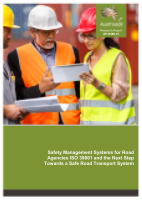Road Safety

- Publication no: AP-R496-15
- ISBN: 978-1-925294-81-1
- Published: 18 November 2015
- PDF (free) Download
This report promotes a systematic approach to road traffic safety within road agencies using ISO 39001 as the template.
The report contains a Starter Guide to implement ISO 39001, a summary of survey results of Australian and New Zealand Road Agencies, a gap analysis and ten recommendations on how to address the current gap in understanding of the role of Safety Management Systems for Road Safety.
The survey results overall suggest that there is substantial variance in awareness of ISO 39001 and safety management systems between Australasian road agencies. The very low level of awareness highlights a lack of safety assurance practices in the provision of road transport services.
There is a strong case for raising awareness and promoting the importance of safety management systems across all road agencies.
The recommendations for Austroads and its members focus on raising awareness, setting context, leadership, planning, monitoring, evaluation and improvement of road safety management systems.
- Summary
- 1. Introduction
- 1.1. Context
- 1.2. Leadership
- 1.3. Planning
- 1.4. Implementation
- 1.5. Monitoring and Evaluation
- 2. Method
- 3. Results
- 4. Survey
- 4.1. Survey Distribution
- 4.2. Treatment of NA and Missing Responses
- 4.3. Scale Score Calculation
- 4.4. Sample Representativeness
- 5. Survey Results
- 5.1. Frequency of Responses to Question 1: ‘Where is your Organisation up to in Relation to ISO 39001?’
- 5.2. Frequency of Responses to: ‘Where are you up to with Road Safety Management Systems?’
- 5.3. Means and Standard Deviations
- 5.4. Comments on Existing Processes and Measures to Manage Road Safety
- 5.5. Local vs State/National Organisation
- 6. Findings of Gap Analysis
- 7. Awareness
- 7.1. Key Survey Findings
- 7.2. Discussion
- 7.2.1. Application of RSMS
- 7.3. Conclusion
- 8. Context
- 8.1. Key Survey Findings
- 8.2. Discussion
- 8.2.1. Scope of RSMS
- 8.2.2. Analysis of Organisation’s Impact on Road Safety
- 8.2.3. Impact of Third Party Suppliers to Road Agencies on Road Safety
- 8.3. Conclusion
- 9. Leadership
- 9.1. Key Survey Findings
- 9.2. Discussion
- 9.2.1. Organisational Leadership
- 9.2.2. Shared Responsibilities from Safe System Philosophy
- 9.2.3. Organisational Development
- 9.3. Conclusion
- 10. Planning
- 10.1. Key Survey Findings
- 10.2. Discussion
- 10.2.1. Factors Affecting Safety Outcomes
- 10.2.2. Performance Measures
- 10.2.3. Application to Asset Improvement, Maintenance and Management
- 10.3. Conclusion
- 11. Implementation
- 11.1. Key Survey Findings
- 11.2. Discussion
- 11.2.1. Documentation of RSMS
- 11.2.2. Key Implementation Functions
- 11.3. Conclusion
- 12. Monitoring, Evaluation and Improvement
- 12.1. Key Survey Findings
- 12.2. Discussion
- 12.3. Conclusion
- References
- Appendix A A Starter’s Guide to Safety Management Systems for Road Agencies
- Working towards the elimination of fatalities and serious injuries – the safe system approach
- A.1 Promoting Road Traffic Safety Management Systems
- A.2 Developing a Road Traffic Safety Management System
- A.3 Six Essential Steps
- A.4 Setting the Context
- A.5 Leadership
- A.6 Planning
- A.7 Intermediate Safety Outcomes
- A.8 Safety Performance Factors
- A.9 Operation, Evaluation and Improvement
- A.10 Potential Processes and Instructions
- Appendix B Recoding of Survey Responses
- B.1 NA and Missing Responses
- Appendix C Survey
- C.1 Introduction
- C.2 Some Optional Background on What We Are Seeking and Why
- C.3 Privacy and Confidentiality
- C.4 Instructions
